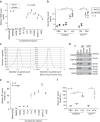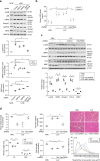Tumor induces muscle wasting in mice through releasing extracellular Hsp70 and Hsp90
- PMID: 28928431
- PMCID: PMC5605540
- DOI: 10.1038/s41467-017-00726-x
Tumor induces muscle wasting in mice through releasing extracellular Hsp70 and Hsp90
Abstract
Cachexia, characterized by muscle wasting, is a major contributor to cancer-related mortality. However, the key cachexins that mediate cancer-induced muscle wasting remain elusive. Here, we show that tumor-released extracellular Hsp70 and Hsp90 are responsible for tumor's capacity to induce muscle wasting. We detected high-level constitutive release of Hsp70 and Hsp90 associated with extracellular vesicles (EVs) from diverse cachexia-inducing tumor cells, resulting in elevated serum levels in mice. Neutralizing extracellular Hsp70/90 or silencing Hsp70/90 expression in tumor cells abrogates tumor-induced muscle catabolism and wasting in cultured myotubes and in mice. Conversely, administration of recombinant Hsp70 and Hsp90 recapitulates the catabolic effects of tumor. In addition, tumor-released Hsp70/90-expressing EVs are necessary and sufficient for tumor-induced muscle wasting. Further, Hsp70 and Hsp90 induce muscle catabolism by activating TLR4, and are responsible for elevation of circulating cytokines. These findings identify tumor-released circulating Hsp70 and Hsp90 as key cachexins causing muscle wasting in mice.Cachexia affects many cancer patients causing weight loss and increasing mortality. Here, the authors identify extracellular Hsp70 and Hsp90, either in soluble form or secreted as part of exosomes from tumor cells, to be responsible for tumor induction of cachexia.
Conflict of interest statement
The authors declare no competing financial interests
Figures










References
Publication types
MeSH terms
Substances
Grants and funding
LinkOut - more resources
Full Text Sources
Other Literature Sources
Molecular Biology Databases

